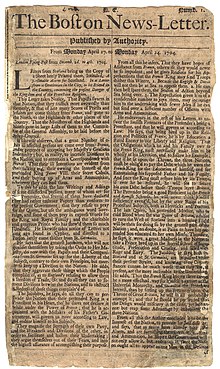The Boston News Letter
The Boston News-Letter , first published April 24, 1704, is believed to be the first continuously published newspaper of the Thirteen Colonies in North America. It was heavily subsidized by the UK government with limited circulation. All expenses were approved by the governor. The first newspaper in the colonies was the Publick Occurrences Both Forreign and Domestick , but it only appeared once on September 25, 1690. The Weekly Jamaica Courant in Kingston followed in 1718 . The Boston Gazette first appeared in 1726 with Bartholomew Green Junior as its printer.
history
The first editor was John Campbell , a bookseller and postmaster in Boston. Campbell had initially written "newsletters" on events in Europe for the governors of New England for a year or more, and he believed he would save himself some trouble if he printed those reports for everyone. The “news letter” was originally published once a week in the format of half a sheet of paper as a single page, which was printed on both sides (8 inches (200 mm) × 12 inches (300 mm)). The printer was Bartholomew Green Sen. In the early years of the "News Letter" the newspaper was mostly filled with news from London papers covering English politics and details of European wars. As the only newspaper in the colonies at the time, it reported on the sensational death of the pirate Blackbeard , who was killed by British soldiers while boarding two supposedly weakly armed ships in 1718.
In 1707, John Allen took care of printing the newspaper. In 1722, the editorship changed to Green, who focused more on local events. After his death in 1732, his son-in-law John Draper, who was also a printer, took over management. He enlarged the sheet to four pages and filled in the news with the events from all the colonies. He continued the newspaper until his death in 1762, at which time his son Richard Draper became the editor. Richard Draper died in 1774 and his widow Margaret Green Draper continued this until the paper was discontinued on February 29, 1776.
Richard Draper was an ardent loyalist, and he supported the motherland during the tumultuous times of the American Revolution in the 1770s. His widow shared his political views, and when a young man named Robert Boyle, whom she had hired as a journalist, showed sympathy for the American Revolution, she replaced him with John Howe . John Howe served as editor-in-chief for Margaret Green Draper until the British evacuated Boston on March 17, 1776. Both Margaret Green Draper and John Howe were taken away by the British. With the British withdrawal, the newspaper ceased to exist. The British government granted Margaret Green Drapere a pension.
Varying newspaper titles
- The Boston news-letter . April 24, 1704 - December 29, 1726.
- The Weekly news-letter . January 5, 1727 - October 29, 1730.
- The Boston weekly news-letter . November 5, 1730 - August 25, 1757.
- The Boston news-letter . September 1, 1757 - March 18, 1762.
- The Boston news-letter, and New-England chronicle . March 25, 1762 - March 31, 1763.
- The Massachusetts gazette . And Boston news-letter . April 7, 1763 - May 19, 1768.
- Boston weekly news letter . May 26, 1768 - September 21, 1769.
- The Massachusetts gazette; and the Boston weekly news-letter . September 28, 1769 - February 29, 1776.
Further literature
- Steven J. Shaw. Colonial Newspaper Advertising: A Step toward Freedom of the Press. The Business History Review , Vol. 33, No. 3 (Autumn, 1959), pp. 409-420
- Thomas S. Martin. The Long and the Short of It: A Newspaper Exchange on the Massachusetts Charters, 1772. The William and Mary Quarterly , Third Series, Vol. 1 (Jan. 1986), pp. 99-110
Web links
- Article in The Boston News Letter
- American Antiquarian Society's pictures from The Boston News Letter
- Dan Hinchen: Advertising in America. In: The Beehive (blog). Massachusetts Historical Society, 2013, accessed November 27, 2016 .
Individual evidence
- ^ Glenn Carrol, Michael T. Hannan : Density Dependence in the Evolution of Populations of Newspaper Organizations. In: American Sociological Review, Volume 54, Issue August 4 , 1989, p. 528 , accessed November 27, 2016 .
- ↑ Colin Woodard: Republic of Pirates Blog. In: republicofpirates.net. December 8, 2007, accessed November 27, 2016 .
- ↑ a b c Article “Boston News Letter” in: “The Encyclopedia Americana (1920)”
- ↑ Colin Woodard: The Republic of Pirates . Harcourt, Inc, 2007, ISBN 978-0-15-603462-3 , pp. 291-296, 366 ( republicofpirates.net ).
- ^ A b Eighteenth-Century American Newspapers in the Library of Congress. The Library of Congress, accessed November 27, 2016 .
